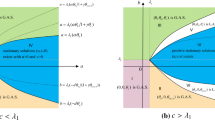Abstract
The present paper deals with analytical investigations of a three species model in an ecosystem involving mutualistic interactions. The model is characterized by a system of first order non-linear ordinary differential equations. We investigate three cases: (1) The death rate of any one (say third) species is greater than its birth rate. (2) The death rate of any two (say second and third) species are greater than their birth rate. (3) The death rate of all the species are greater than their birth rate. Further, we establish all the equilibrium points and stability criteria for the model.
Similar content being viewed by others
References
Addicott John F.: Stability properties of two species models of mutualism: simulation studies. Oecologia 49(1), 42–49 (1981)
Brauer F., Castillo-Chavez C.: Mathematical Models in Population Biology and Epidemiology. Springer, New York (2001)
Braun M.: Differential Equations and Their Applications—Applied Mathematical Sciences (15). Springer, New York (1983)
Dean A.M.: A simple model of mutualism. Am. Nat. 121(3), 409–417 (1983)
Edelstein-Keshet L.: Mathematical Models in Biology. SIAM, New York (2005)
Goh B.S.: Stability in models of mutualism. Am. Nat. 113(2), 261–275 (1979)
Gyllenberg M., Yan P., Wang Y.: Limit cycles for competitor-competitor-mutualist Lotka-Volterra systems. Physica D 221, 135–145 (2006)
Hirsch M.W., Smale S., Devaney R.L.: Differential Equations, Dynamical Systems and an Introduction to Chaos. Elsevier, New York (2004)
Kapur J.N.: Mathematical Models in Biology and Medicine. Affiliated East-West Private Ltd., New Delhi (1985)
Lotka A.J.: Elements of Physical Biology. Williams and Wilkins Company, Baltimore, MD (1925)
May R.M.: Stability and Complexity in Model Ecosystems. Princeton University Press, Princeton (1973)
Naji R.K., Balasim A.T.: On the dynamical behavior of three species food web model. Chaos Solitons Fractals 34, 1636–1648 (2007)
Odum E.P.: Fundamentals of Ecology, 3rd edn. Saunders, Philadelphia (1971)
Smith J.M.: Models in Ecology. Cambridge University Press, Cambridge (1974)
Stiling P.: Ecology-Theories and Applications. PHI Learning Private Limited, New Delhi (2009)
Wang Y., Wu H.: A mutualism-competition model characterizing competitors with mutualism at low density. Math. Comput. Model. 53, 1654–1663 (2011)
Wolin C.L.: The Population Dynamics of Mutualistic System. In: Boucher, D.H. (ed.) The Biology of Mutualism, pp. 248–269. Oxford University Press, New York (1985)
Zhibin Z.: Mutualism or cooperation among competitors promotes coexistence and competitive ability. Ecol. Model. 164, 271–282 (2003)
Author information
Authors and Affiliations
Corresponding author
Rights and permissions
About this article
Cite this article
Dhakne, M.B., Munde, A.B. Stability Analysis of Mutualistic Interactions Among Three Species with Limited Resources for First Species and Unlimited Resources for Second and Third Species. Differ Equ Dyn Syst 20, 405–414 (2012). https://doi.org/10.1007/s12591-012-0120-z
Published:
Issue Date:
DOI: https://doi.org/10.1007/s12591-012-0120-z




